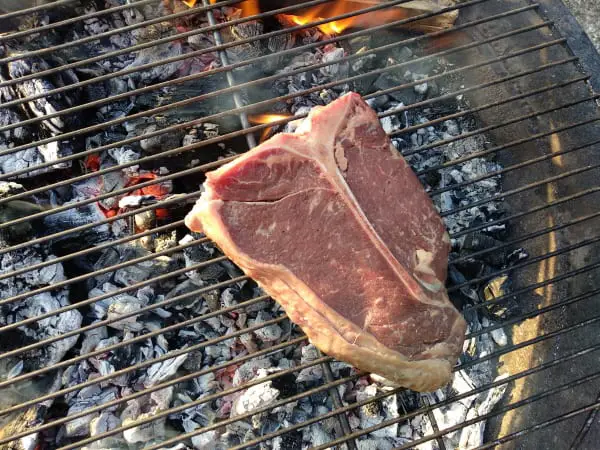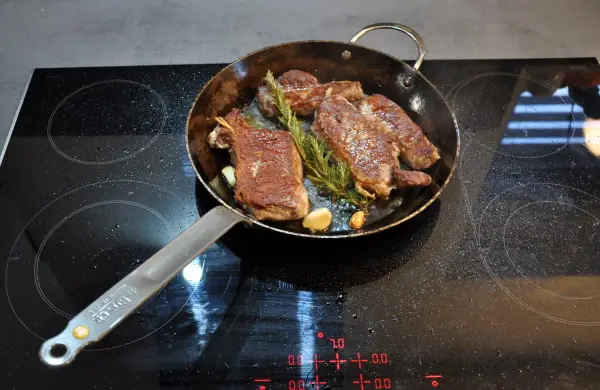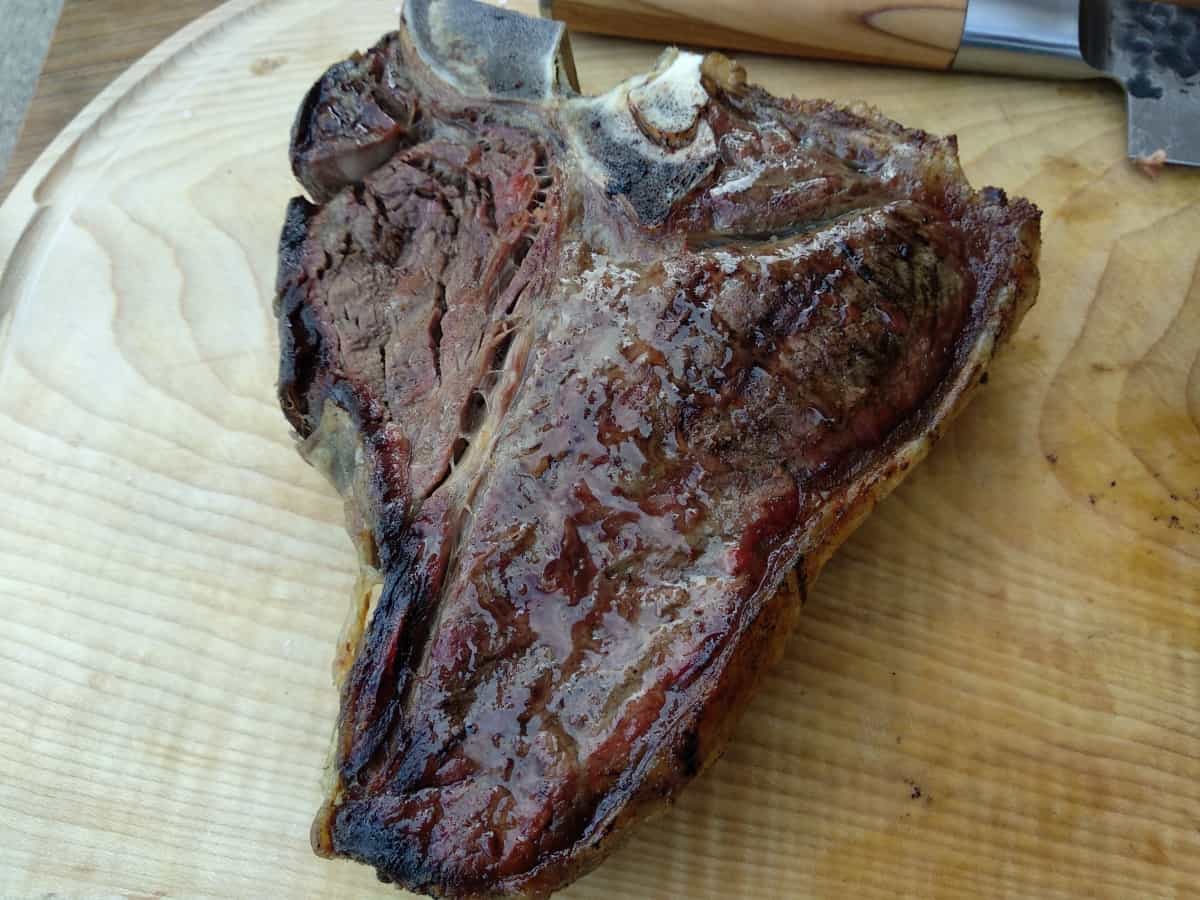When it comes to cooking steak, there are a few things that you need to take into account to make sure that your steak turns out perfectly. The first is the type of oil that you use. While there are a variety of oils that you can use for cooking, not all of them are created equal when it comes to cooking steak. To get the best results, you’ll want to use an oil that has a high smoke point. This will ensure that your steak doesn’t end up tasting burnt or bitter.
Some of the best oils for cooking steak include avocado oil, grapeseed oil, and coconut oil. These oils all have a high smoke point, which means that they can withstand the high heat of the grill or stove without burning. Additionally, these oils all have a neutral flavor, so they won’t alter the taste of your steak.
Factors to Consider when Choosing Oil for steak
Choosing the best oil for cooking your steak can seem daunting, but it’s essential to find one that complements the flavor of the meat and performs well under high heat. The perfect oil should have a high smoke point, a pleasant taste, and provide health benefits.
The smoke point is crucial because oils with lower smoke points can burn and produce a bitter taste. Look for an oil with a smoke point of at least 400°F (204°C), as most cooking methods for steak require high heat.
Flavor is another key factor. Some oils have neutral tastes, like canola and grapeseed oil, while others can enhance the flavor of your steak, such as peanut or extra virgin olive oil. Consider your personal preferences and the desired outcome when making a choice.
Lastly, consider the health benefits of the oil. Oils like extra virgin olive oil and avocado oil are known for their healthy fats and antioxidant properties. Opting for these can add a nutritious aspect to your meal.
Breaking down the best oils for cooking steak
Refined avocado oil stands out as the best oil for cooking steak if you had to choose just one. With its high smoke point of around 500°F (260°C), it allows you to cook at high temperatures without breaking down and producing harmful compounds. In addition, refined avocado oil has a mild flavor that won’t overpower the natural taste of your steak.
Furthermore, it contains heart-healthy monounsaturated fats and is a good source of vitamin E and antioxidants. So, not only does it perform well in the kitchen, but it also provides some health benefits.
Looking for the perfect oil to cook your steak? We’ve got you covered! We’ve rated various oils based on their suitability for cooking steak, considering factors like smoke point and flavor. Check out our handy table below to find the best match for your culinary needs.
| Best oil for cooking steak | |||
|---|---|---|---|
| Oil | Smoking point in fahrenheit | Smoke point in Celsius | Usage when cooking steak |
| Refined avocado oil | 520°F | 271°C | Mild nutty flovor / Great for steaks |
| Extra virgin olive oil | 405°F | 207°C | Herb and fruity flavor / Great for steaks |
| Grapeseed oil | 420°F | 215°C | Slightly bitter flavor / Great for steaks |
| Peanut oil | 450°F | 230°C | Mild nutty flovor / Great for steaks |
| Vegetable oil | 400-450°F | 205-230°C | Natural taste / Great for steaks |
| Coconut oil | 400-450°F | 205-230°C | Natural taste / Ok for steaks |
| Corn oil | 450°F | 230°C | Natural taste / Ok for steaks |
| Sunflower oil | 440°F | 225°C | Very strong taste / Not the best for steaks |
| Sesame oil | 350-410°F | 175-210°C | Natural, slightly nutty taste / Ok for steaks |
| Canola oil | 400°F | 205°C | Mild flavor / Ok for steaks |
| Avocado oil | 375-400°F | 190-205°C | Mild nutty flovor / Semi ok for steaks |
| Truffle oil | 356°F | 180°C | Complex flavor / NOK for steaks |
| MCT oil | 320°F | 160°C | Complex flavor / NOK for steaks |
Last update on 2025-06-17 / Affiliate links / Images from Amazon Product Advertising API
Refined Avocado Oil
I’ve been loving refined avocado oil for cooking steaks lately. Extracted from avocados, this oil is rich in heart-healthy fats and vitamins. Refined avocado oil has a high smoke point of around 520°F (270°C), making it ideal for high-heat cooking. It’s a bit pricier than some other oils, but it’s definitely worth it.
Using refined avocado oil for steak ensures an even sear and crispy crust without imparting a strong flavor. It’s suitable for all steak types, from beef and pork to fish steaks. Besides steaks, refined avocado oil is perfect for frying, sautéing, and roasting other dishes too.
Pros:
- High smoke point
- Rich in monounsaturated fats
- Neutral flavor
Cons:
- More expensive than other oils
- Not easily available in all stores
- Limited versatility beyond high-heat cooking
Extra Virgin Olive Oil
Extra virgin olive oil is a staple in my kitchen when it comes to cooking steaks. This oil is packed with antioxidants and healthy fats. It has a lower smoke point of about 375°F (190°C), which makes it more suitable for medium-heat cooking. While slightly more expensive than some oils, it’s a fantastic choice for flavor and health benefits.
Using extra virgin olive oil for steak brings a rich, fruity flavor to the meat. It works well with a variety of steak types, including beef, pork, and fish steaks like tuna. Apart from steak, extra virgin olive oil is a versatile choice for salads, pasta dishes, and marinades.
Pros:
- Rich in antioxidants and healthy monounsaturated fats
- Enhances flavor of the steak
- Widely available
Cons:
- Lower smoke point than other oils
- Can be expensive
- Flavor might not be suitable for all steak dishes
Grapeseed Oil
Grapeseed oil has become a favorite of mine for cooking steaks. Derived from grape seeds, this oil is high in polyunsaturated fats and antioxidants. With a smoke point of about 420°F (215°C), it’s great for medium to high-heat cooking. Grapeseed oil is relatively affordable, making it a popular choice in many kitchens.
Cooking steak with grapeseed oil results in a beautiful sear without altering the meat’s natural flavors. It’s suitable for a range of steak types, from beef and pork to fish steaks. Beyond steaks, grapeseed oil is fantastic for sautéing, stir-frying, and baking.
Pros:
- High smoke point
- Neutral flavor
- Rich in antioxidants
Cons:
- Can be expensive
- Sometimes made from GMO grapes
- Lacks distinct flavor profile
Peanut Oil
I’ve been using peanut oil for cooking steaks, and I’m quite impressed with the results. Extracted from peanuts, this oil is high in monounsaturated fats and has a smoke point of around 450°F (232°C), making it excellent for high-heat cooking. It’s moderately priced, providing a great balance of cost and performance.
Peanut oil adds a subtle, nutty flavor to steaks and works well with various steak types, including beef, pork, and fish steaks. In addition to steak, peanut oil is a popular choice for frying and stir-frying other dishes.
Pros:
- High smoke point
- Adds a nutty flavor
- Widely available
Cons:
- Not suitable for those with peanut allergies
- High in omega-6 fatty acids
- May not be suitable for all types of steak dishes
Vegetable Oil
Vegetable oil is a versatile option for cooking steaks, as it’s usually a blend of different plant-based oils. It’s high in unsaturated fats and has a smoke point of around 400-450°F (204-232°C), making it suitable for medium to high-heat cooking. It’s also relatively affordable.
When using vegetable oil for steak, it doesn’t impart a strong flavor, allowing the meat’s natural taste to shine. It’s suitable for various steak types, from beef and pork to fish steaks. Vegetable oil is also a go-to for frying, sautéing, and baking.
Pros:
- High smoke point
- Inexpensive
- Neutral flavor
Cons:
- Highly processed
- High in omega-6 fatty acids
- May contain GMOs
Coconut Oil
Lately, I’ve been trying out coconut oil for cooking steaks, and it’s been a delightful experience. Derived from the meat of coconuts, this oil is rich in saturated fats, which makes it a unique choice for cooking. It has a smoke point of around 350°F (177°C) for unrefined and 450°F (232°C) for refined, so it’s well-suited for medium to high-heat cooking. Keep in mind that it’s a bit more expensive than some other oils, but the distinct flavor and potential health benefits make it worth considering.
When using coconut oil for cooking steak, it imparts a subtle, tropical flavor to the meat, adding a unique twist to your dish. It works well with various steak types, including beef, pork, and fish steaks. Beyond steak, coconut oil is fantastic for frying, sautéing, baking, and making vegan or dairy-free dishes, thanks to its creamy consistency and mild flavor.
Pros:
- High smoke point
- Unique flavor
- Rich in healthy saturated fats
Cons:
- Solid at room temperature
- Flavor might not be suitable for all steak dishes
- Can be expensive
Corn Oil
I’ve recently been experimenting with corn oil for cooking steaks, and it’s been working out quite well. Extracted from corn, this oil is high in polyunsaturated fats and has a smoke point of around 450°F (232°C), making it great for high-heat cooking. It’s relatively affordable, too.
Using corn oil for steak doesn’t impart a strong flavor, allowing the meat’s natural taste to take center stage. It’s suitable for a variety of steak types, including beef, pork, and fish steaks. Corn oil is also a popular choice for frying, sautéing, and baking.
Pros:
- High smoke point
- Inexpensive
- Neutral flavor
Cons:
- Highly processed
- High in omega-6 fatty acids
- May contain GMOs
Sunflower Oil
Sunflower oil has become a go-to option for cooking steaks in my kitchen. Derived from sunflower seeds, this oil is high in monounsaturated fats and has a smoke point of about 440°F (227°C), which is suitable for high-heat cooking. It’s quite affordable, making it a popular choice among many cooks.
When using sunflower oil for cooking steak, it produces a great sear without adding any strong flavors. It’s suitable for various steak types, from beef and pork to fish steaks. Sunflower oil is also fantastic for frying, sautéing, and baking other dishes.
Pros:
- High smoke point
- Neutral flavor
- Rich in vitamin E
Cons:
- High in omega-6 fatty acids
- May be made from GMO sunflowers
- Less healthy than other oils
Sesame Oil
Sesame oil is a unique choice for cooking steaks, and I’ve been enjoying the results. Extracted from sesame seeds, this oil is high in polyunsaturated fats and has a smoke point of about 350°F (177°C) for unrefined and 410°F (210°C) for refined, making it suitable for medium to high-heat cooking. It’s a bit pricier than some other oils, but the distinctive flavor is worth the investment.
Cooking steak with sesame oil imparts a rich, nutty flavor to the meat, which can elevate the taste of various steak types, including beef, pork, and fish steaks. Apart from steak, sesame oil is popular for stir-frying, sautéing, and making dressings and marinades.
Pros:
- High smoke point
- Rich in antioxidants
- Distinct flavor profile
Cons:
- Can be expensive
- Flavor might not be suitable for all steak dishes
- Not as widely available as other oils
Canola Oil
Canola oil is another versatile option for cooking steaks. Made from rapeseeds, this oil is high in monounsaturated fats and has a smoke point of around 400°F (204°C), making it ideal for medium to high-heat cooking. It’s also quite affordable.
Using canola oil for cooking steak allows for an even sear without introducing any strong flavors, letting the meat’s natural taste shine through. It’s suitable for various steak types, from beef and pork to fish steaks. Canola oil is a popular choice for frying, sautéing, and baking other dishes as well.
Pros:
- High smoke point
- Inexpensive
- Neutral flavor
Cons:
- Highly processed
- May contain GMOs
- High in omega-6 fatty acids
Avocado Oil
I’ve been loving unrefined avocado oil for cooking steaks lately. Just like refined avocado oil, it’s rich in heart-healthy fats and vitamins, but it has a lower smoke point of around 375-400°F (190-204°C), making it better for medium-heat cooking. It’s a bit pricier than some other oils, but the health benefits and unique flavor make it worthwhile.
Cooking steak with unrefined avocado oil imparts a subtle, buttery flavor to the meat. It’s suitable for all steak types, from beef and pork to fish steaks. Besides steaks, unrefined avocado oil is perfect for sautéing, roasting, and making dressings and marinades.
Pros:
- High smoke point
- Rich in monounsaturated fats
- Neutral flavor
Cons:
- More expensive than other oils
- Not easily available in all stores
- Unrefined version has a lower smoke point
Best Oils for Cooking Steak with Different Methods

Best Oil for Pan Frying Steak
When pan frying a steak, you need an oil with a high smoke point to avoid burning and creating an unpleasant taste. Refined avocado oil is a great choice because it has a high smoke point of around 520°F (271°C), making it perfect for high-heat cooking. Additionally, it has a mild flavor that won’t overpower the taste of the steak.
Best Oil for Cast Iron Steak
Cooking a steak in a cast iron skillet requires an oil that can handle high heat and provide a nice sear. Grapeseed oil is an excellent option for cast iron cooking. Its high smoke point of about 420°F (216°C) allows you to get a beautiful crust on your steak without the oil breaking down. Grapeseed oil also has a neutral flavor that won’t interfere with the taste of the meat.
Best Oil for BBQ Steak
When grilling a steak on the BBQ, you’ll want an oil that can withstand high temperatures and enhance the flavor of the meat. Peanut oil is a fantastic choice for BBQ steak. With a smoke point of approximately 450°F (232°C), it can handle the heat of the grill, and its slightly nutty flavor adds an extra layer of deliciousness to your steak.
Best Oil for Broiling Steak
Broiling steak is another popular method that requires high heat. Canola oil is a versatile and cost-effective choice for broiling. Its smoke point is around 400°F (204°C), allowing it to hold up well under the intense heat of the broiler. Canola oil also has a neutral taste, so it won’t compete with the flavor of your steak.
Related questions
Can you mix oils when cooking steak for better results?
Yes, mixing oils when cooking steak can yield better results, as it allows you to combine the unique properties and flavors of different oils. For instance, you might mix an oil with a high smoke point, like avocado oil or grapeseed oil, with a more flavorful oil, like extra virgin olive oil or sesame oil. This approach provides the heat resistance necessary for cooking steak while also enhancing the taste. However, it’s essential to consider the smoke points and flavors of each oil to ensure a successful combination.
Are there any oils to avoid when cooking steak?
When cooking steak, it’s best to avoid oils with low smoke points or strong flavors that might overpower the meat. For example, flaxseed oil and unrefined oils have low smoke points and may break down quickly under high heat, producing smoke and unpleasant flavors. Additionally, some oils, like pumpkin seed oil or walnut oil, have distinctive flavors that might not complement the taste of steak. Instead, opt for oils with high smoke points and neutral or complementary flavors.
Is it important to heat the pan before adding oil?
Yes, it’s important to heat the pan before adding oil when cooking steak. Preheating the pan ensures even heat distribution, which allows the steak to cook uniformly and develop a beautiful crust. To properly preheat your pan, place it over medium-high heat until it’s hot but not smoking. Then, add the oil and wait until it starts to shimmer before placing the steak in the pan. This approach helps prevent the steak from sticking to the pan and promotes a desirable sear.
Should you oil the steak before seasoning?
Oiling the steak before seasoning can be beneficial, as it helps the seasonings adhere to the meat and creates a barrier that prevents the steak from sticking to the pan. To oil the steak, pat it dry with paper towels, then lightly coat it with oil on both sides. Afterward, apply your desired seasonings, pressing them gently into the meat to ensure they stick. This method not only enhances flavor but also promotes even cooking and a nice crust.
Healthiest Oils for Cooking Steak
When choosing the healthiest oils for cooking steak, consider options rich in heart-healthy fats and antioxidants. Extra virgin olive oil, avocado oil, and grapeseed oil are all excellent choices. Extra virgin olive oil is high in monounsaturated fats and antioxidants, which can help reduce inflammation and lower the risk of heart disease. Avocado oil also contains monounsaturated fats and is suitable for high-heat cooking due to its high smoke point. Grapeseed oil is another healthy option, with a high smoke point and a good balance of omega-6 and omega-3 fatty acids, making it suitable for cooking steak without sacrificing health benefits.
The Perfect Steak recipe with the best oil: A Step-by-Step Guide

Recipe 1: Rosemary-Garlic Steak with Extra Virgin Olive Oil
Ingredients:
- 2 ribeye steaks (8 oz each), at room temperature
- 3 tablespoons extra virgin olive oil
- 2 cloves garlic, minced
- 2 tablespoons fresh rosemary, finely chopped
- Salt and freshly ground black pepper, to taste
Recipe Steps:
- In a small bowl, mix together the extra virgin olive oil, minced garlic, and chopped rosemary.
- Pat the steaks dry with paper towels and generously season them with salt and freshly ground black pepper on both sides.
- Rub the olive oil mixture onto both sides of each steak, ensuring an even coating.
- Preheat a grill or grill pan to medium-high heat. Once hot, place the steaks on the grill or pan.
- Cook the steaks for 4-5 minutes per side for medium-rare, or until they reach your desired level of doneness.
- Remove the steaks from the grill or pan, and let them rest for 5 minutes to allow the juices to redistribute.
- Slice and serve the steaks with your choice of sides.
Recipe 2: Herb-Crusted Steak with Avocado Oil
Ingredients:
- 2 New York strip steaks (8 oz each), at room temperature
- 3 tablespoons avocado oil
- 1 tablespoon fresh thyme leaves, finely chopped
- 1 tablespoon fresh parsley, finely chopped
- 1 tablespoon fresh chives, finely chopped
- Salt and freshly ground black pepper, to taste
Recipe Steps:
- In a small bowl, mix together the avocado oil, chopped thyme, parsley, and chives.
- Pat the steaks dry with paper towels and generously season them with salt and freshly ground black pepper on both sides.
- Rub the herb and oil mixture onto both sides of each steak, ensuring an even coating.
- Preheat a cast iron skillet or heavy-bottomed pan over medium-high heat. Once hot, add the steaks to the skillet or pan.
- Cook the steaks for 4-5 minutes per side for medium-rare, or until they reach your desired level of doneness. For a more even crust, press the steaks gently with a spatula while cooking.
- Remove the steaks from the skillet or pan, and let them rest for 5 minutes to allow the juices to redistribute.
- Slice and serve the steaks with your choice of sides.






